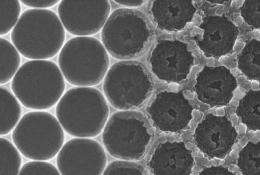Faster, cheaper gas and liquid separation using custom designed and built mesoscopic structures

In what may prove to be a significant boon for industry, separating mixtures of liquids or gasses has just become considerably easier.
Using a new process they describe as "reverse fossilization," scientists at Kyoto University's WPI Institute for Integrated Cell-Material Sciences (iCeMS) have succeeded in creating custom designed porous substances capable of low cost, high efficiency separation.
The process takes place in the mesoscopic realm, between the nano- and the macroscopic, beginning with the creation of a shaped mineral template, in this case using alumina, or aluminum oxide. This is then transformed into an equivalently shaped lattice consisting entirely of porous coordination polymer (PCP) crystals, which are themselves hybrid assemblies of organic and mineral elements.
"After creating the alumina lattice," explains team leader Assoc. Prof. Shuhei Furukawa, "we transformed it, molecule for molecule, from a metal structure into a largely non-metallic one. Hence the term 'reverse fossilization,' taking something inorganic and making it organic, all while preserving its shape and form."
After succeeding in creating both 2-dimensional and 3-dimensional test architectures using this technique, the researchers proceeded to replicate an alumina aerogel with a highly open, sponge-like macro-structure, in order to test its utility in separating water and ethanol.
"Water/ethanol separation has not been commonly possible using existing porous materials," elaborates Dr. Julien Reboul. "The PCP-based structures we created, however, combine the intrinsic nano-level adsorptive properties of the PCPs themselves with the meso- and macroscopic properties of the template aerogels, greatly increasing separation efficiency and capacity."
Lab head and iCeMS Deputy Director Prof. Susumu Kitagawa sees the team's achievement as a significant advance. "To date, PCPs have been shown on their own to possess highly useful properties including storage, catalysis, and sensing, but the very utility of the size of their nanoscale pores has limited their applicability to high throughput industrial processes. Using reverse fossilization to create architectures including larger, mesoscale pores now allows us to begin considering the design of such applications."
More information: "Mesoscopic architectures of porous coordination polymers fabricated by pseudomorphic replication," Julien Reboul, et.al, Nature Materials, June 24, 2012 .
Journal information: Nature Materials
Provided by Kyoto University

















